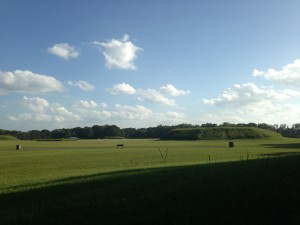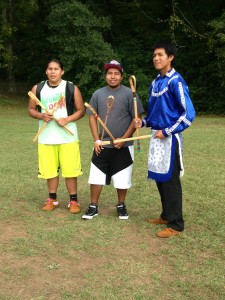In the efforts to convert Native American people to Christianity, groups such as the Jesuits founded missions. While these missionaries’ goals were to Christianize the population, and in their belief, save the native peoples’ souls—they were also in the process of erasing the culture of the tribe. An account of some late attempts by the correspondents of the Society for Propagating Christian Knowledge to Christianize the North American Indians, by the Society in Scotland for Propagating Christian Knowledge, detailed the spread of Christianity among Mohawks in the 1760s, and the ways that it seemed to be achieved. Another document narrated an encounter with the Mohawk tribe, The Character of the Five Indian Nations of Canada, by Lord Cadwallader Colden, and presents a picture of the declining state of the tribe in 1727, which shows another perspective on why the Mohawk Indians may have been willing to convert to Christianity.
An account of some late attempts, came from the perspective of the missionaries, and gave a look into their process of converting the Mohawk tribe to Christianity. It shows that the Mohawks were involved with Christianity at the time, however, considering the bias of the source there is a possibility that the author decided to omit any religious practices that did not fit in with the authors definition of Christianity, or some Mohawks that may not have accepted the new religion. Throughout the piece, the missionaries stress the Mohawks devoutness. In one instance the essay described a mass at Sabbath, “a very full and attentive assembly, as devout as ever I saw, and properly raised with a well-tempered zeal.”[1] the author emphasized the extreme reactions the people had to the sermon, during which, “The whole assembly was moved…some wept and covered their faces.”[2]
By describing the Indians’ reaction to Christianity, the author tried to prove that Mohawk Indians were easily adopting the religion, and were incredibly taken by it. They further stressed how many were eager to convert and incorporate this new religion into their lives (which would ultimately influence their culture). Some Indians are said to be concerned about their soul, and what they should do in order to be favored by God. Others are already well established in Christianity and are “zealously engaged”[3] in their practices. Did the Mohawk tribes actually lose all of their old customs, as the author would like to indicate? There is an excerpt in the same document that notes how children play a vital role in the process of acculturating the Mohawk tribe. It is explained that they need to set up schools among the villages where the Indian children can learn English teachings so that they may become interpreters, or missionaries themselves.[4] If this process is read into, one may realize that the more the children are being subjected to a different religion, customs, and rituals, the less time they have for their own cultural practices—which may cause them to be phased out entirely.
If the Mohawks adoption of religion wasn’t solely due to the desire to be accepted by the Christian God, then what were the other causes? The Character of the Five Indian Nations of Canada, by Lord Cadwallader Colden gives insight on this. Colden explains that the Mohawks were part of The Five Nations, an Iroquois Indian confederacy of New York, comprised of the Mohawk, Oneida, Onondaga, Cayuga, and Seneca tribes, and while he describes the people as barbaric he also points to the fact that many of the tribes were at war with each other. One can infer, that due to war, deaths, and dwindling populations in tribes, that The Five Nations banded together largely in part because they were vulnerable to attack due to these weaknesses.[5] Their practices are as described, “An old Mohawk Sachem, in a poor blanket and dirty shirt, may be seen issuing his orders with as arbitrary authority as a Roman dictator.”[6] They are not trying to put the Mohawks in a good light, and their descriptions of them differ greatly from that of the missionaries where they call them devout and well-tempered. In this case, the author wants to demean their authority, he pointed out that it was all arbitrary, that their power wasn’t actually substantial. He wanted to portray them as weak, and their state as shabby, by comparing the Mohawks to his own standard of living and expectations. However, despite the negative connotations, this shows how war was a very important practice in the Mohawks culture.
So why did this tribe convert to Christianity, and allow for the missionaries to be built on their land? The answer, in examining the documents, seems more complicated than the missionaries would want one to believe. Due to the fact that the Mohawks became part of The Five Nations, it seems as if they did not have as large of a population as they were used to, as they chose to band together with other tribes instead of continuing on alone like they had in the past. With less numbers, comes less power, and the missionaries would have had an easier time influencing the tribe to join them because of it. If they accepted the missionaries, it brought the Mohawks protection from other tribes, which may have been a deciding factor to allow the missionaries onto their land in the first place.. The missionaries also seemed to start indoctrinating children at a young age to their faith, which meant that it was easier for the religion to take root in the tribe. As a result, new aspects may have been added to what constituted as Mohawk culture, while older ideas could have been forgotten. The sources provide a glimpse of Mohawk life, culture, and religion—though they depict it with heavy bias included. From the missionaries point of view, they portray the Mohawks as zealous, and as the perfect receptacle of Christianity, that they love everything that is happening in order to lead people to believe that they are doing nothing but succeeding in their Christianization of the Indians. By comparison, the other document was biased in that it wanted to show the Mohawks in a negative light, and insinuate that they held no power, and were a poor people. However, by reading into them, one can see that this shift toward Christianity may have occurred, and that numerous factors probably fostered this change. By using these sources, one could answer how the Mohawks became Christian, and what events led up to the incorporation of this religion in their tribe. They could also be used to look at the shift in culture in the Mohawk tribe, to see if the missionaries influence played a part in any new traditions the Mohawks adopted.
[1] Society in Scotland for Propagating Christian Knowledge, An account of some late attempts by the correspondents of the Society for Propagating Christian Knowledge to Christianize the North American Indians, (Edinburgh, 1763), 6.
[2] Society in Scotland for Propagating Christian Knowledge, 6.
[3] Society in Scotland for Propagating Christian Knowledge, 7.
[4] Society in Scotland for Propagating Christian Knowledge, 9.
[5] Cadwallader Colden, “The Character of the Five Indian Nations of Canada, by Lord Cadwallader Colden,” in The Origin of the North American Indians: with a Faithful Description of Their Manners and Customs, Both Civil and Military, Their Religions, Languages, Dress, and Ornaments, New ed., ed. John McIntosh (New York, N: Nafis & Cornish, 1843), 301-303.
[6] Colden, ” The Character of the Five Indian Nations of Canada, by Lord Cadwallader Colden,” 304.
Works Cited
Cadwallader Colden, ” The Character of the Five Indian Nations of Canada, by Lord Cadwallader Colden,” in The Origin of the North American Indians: with a Faithful Description of Their Manners and Customs, Both Civil and Military, Their Religions, Languages, Dress, and Ornaments, New ed., ed. John McIntosh (New York, N: Nafis & Cornish, 1843), 301-307. < http://solomon.eena.alexanderstreet.com.libdata.lib.ua.edu/cgi-bin/asp/philo/eena/getpart.pl?S2995-D128>
Society in Scotland for Propagating Christian Knowledge, An account of some late attempts by the correspondents of the Society for Propagating Christian Knowledge to Christianize the North American Indians (Edinburgh, 1763), <http://galenet.galegroup.com.libdata.lib.ua.edu/servlet/Sabin?af=RN&ae=CY105042216&srchtp=a&ste=14>

